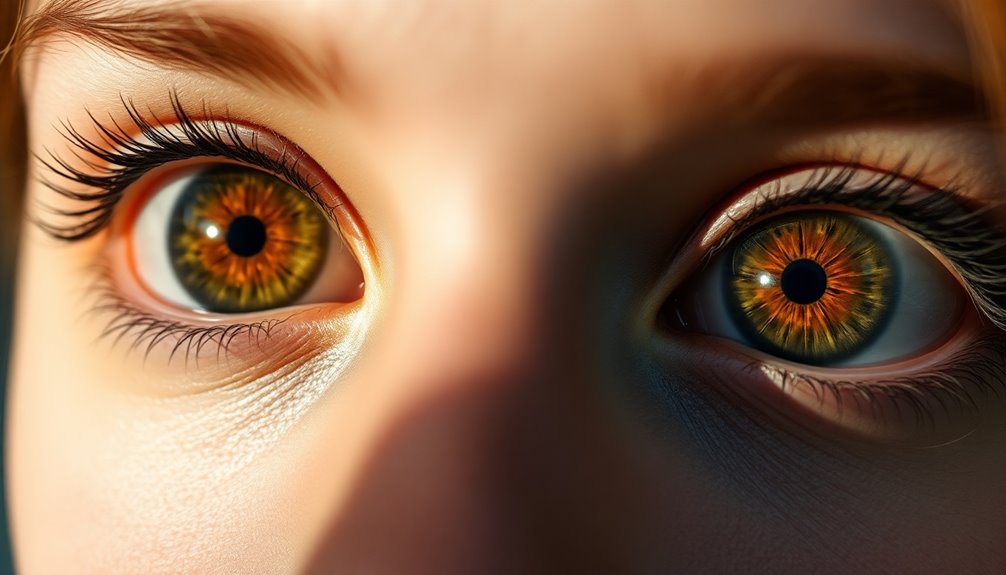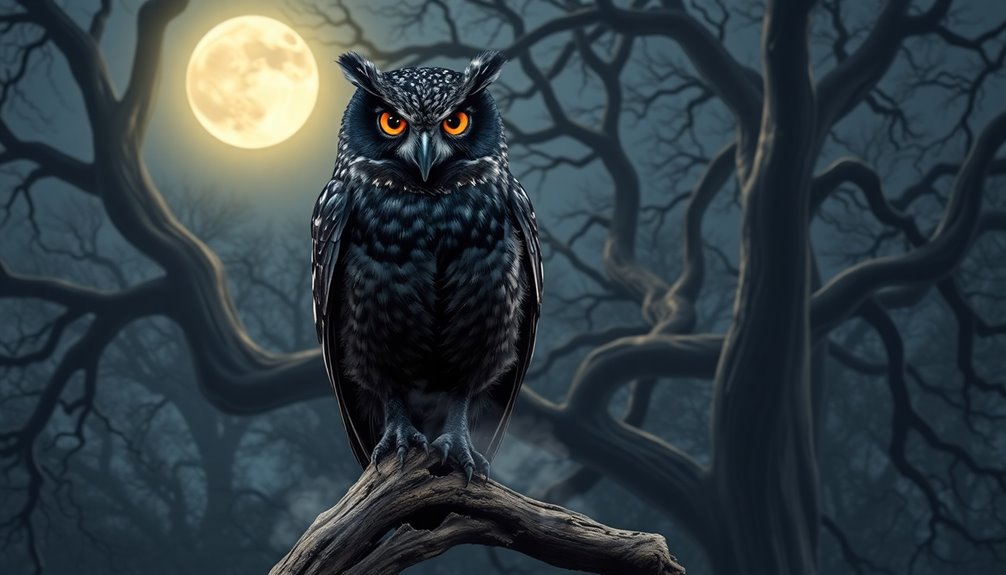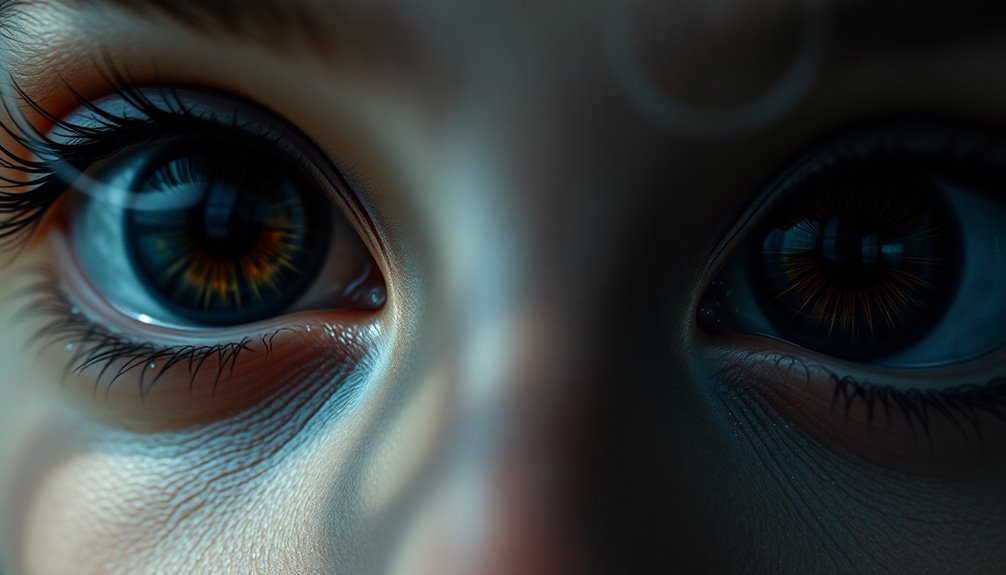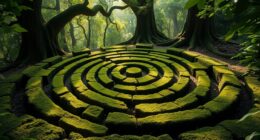Hazel eyes symbolize a rich tapestry of traits and beliefs. You'll find connections to ancient wisdom and intuition in Celtic mythology, and healing energy in Native American traditions. People with hazel eyes often exhibit passion and emotional intelligence, drawing you into their captivating gaze, which can even shift colors with their moods. Their allure is celebrated in art, literature, and cultural folklore, tying them to themes of transformation and creativity. With notable figures like Rihanna and Tom Cruise embodying this mystique, there's plenty more to uncover about the significance of hazel eyes in different contexts.
Key Takeaways
- Hazel eyes symbolize ancient wisdom and intuition, as linked to the hazel tree in Celtic mythology.
- They represent healing and emotional well-being in Native American beliefs, enhancing connections with nature spirits.
- In Chinese astrology, hazel eyes align with creativity and adaptability, associated with the wood element.
- Artistic and cultural representations celebrate hazel eyes for their depth, mystery, and connection to rebirth in various mythologies.
- Notable individuals with hazel eyes, like Rihanna and Tom Cruise, embody the adventurous and dynamic personality traits often associated with this eye color.
Spiritual and Cultural Significance
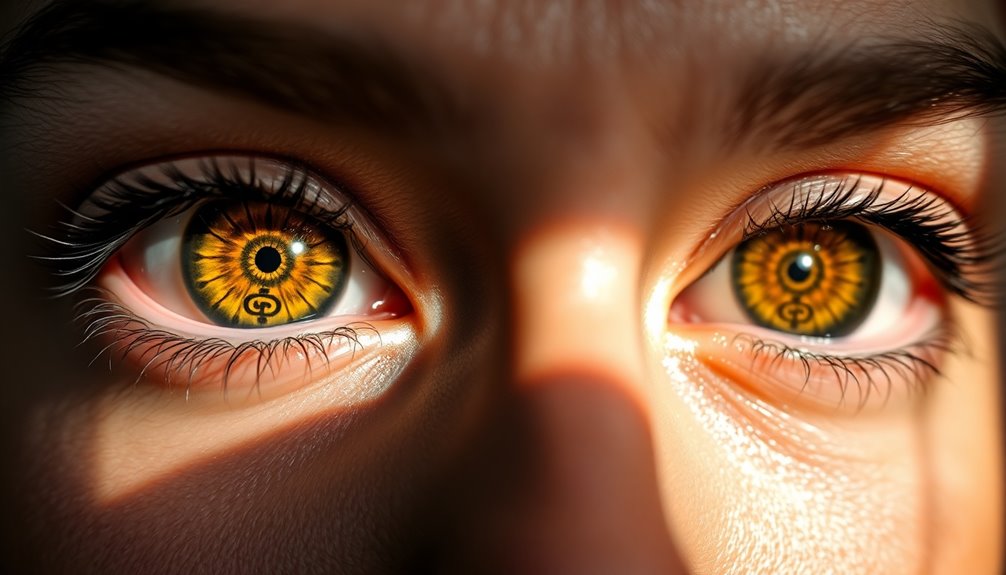
Hazel eyes carry profound spiritual and cultural significance across various traditions. In Celtic mythology, these eyes connect you to the ancient wisdom of the hazel tree, symbolizing knowledge and intuition. If you possess hazel eyes, you might find that others perceive you as having strong intuitive senses, aiding your self-understanding and insight into others.
In Native American culture, hazel eyes are believed to hold powerful healing energy, promoting both physical and emotional well-being. This spiritual attribute enhances your ability to adapt and transform, reflecting a connection to earth and fire elements. Additionally, many Indigenous cultures, such as the Hopi Tribe, view natural features as integral to their identity and spirituality. Hazel eyes are often considered a rare eye color, which adds to their mystique and allure.
Moreover, hazel eyes symbolize spiritual growth, representing your journey and shifts in perspective. In Eastern traditions, particularly Chinese astrology, these eyes align with the element of wood, signifying creativity and adaptability.
Ancient Egyptians linked hazel eyes to rebirth and resurrection, emphasizing their spiritual depth.
Finally, in Christian symbolism, the green hues within hazel eyes represent growth and renewal, reinforcing your connection to the divine. Overall, hazel eyes encapsulate a rich tapestry of spiritual and cultural meanings, inviting deeper exploration into their significance.
Connection to Nature

The rich spiritual and cultural meanings of hazel eyes naturally extend into their connection to nature. In Celtic mythology, hazel trees symbolize wisdom, with hazel-eyed individuals believed to embody this ancient knowledge. Additionally, the significance of cultural heritage can enhance one's understanding of the world around them.
Similarly, in Native American culture, your hazel eyes might be seen as a source of healing energy, enabling you to communicate with nature spirits. This connection to the earth enhances your emotional and physical well-being. The unique blend of colors in hazel eyes, which includes green and brown, further emphasizes this bond with the natural world. Additionally, engaging with nature can foster emotional intelligence that enhances your ability to connect with others and understand your own feelings.
The color green, often associated with hazel eyes, represents renewal and rebirth, linking you to spiritual awakening. Folklore frequently ties hazel eyes to magic and the divine, suggesting that you possess unique abilities to navigate life's complexities. Moreover, the intricate designs of traditional art forms, such as decor masks, can reflect the beauty and depth of your experiences.
With their earthy tones, your eyes reflect the beauty of forests and fertile lands, grounding you in nature. When you spend time outdoors, you likely feel a profound sense of balance and harmony, which resonates with the dynamic colors of your hazel eyes.
This adaptability mirrors your spiritual journey, allowing you to tap into the healing energies that nature offers. Embracing these connections can guide you through uncertainties, enriching your life with deeper insights and emotional depth.
Personality and Psychological Traits
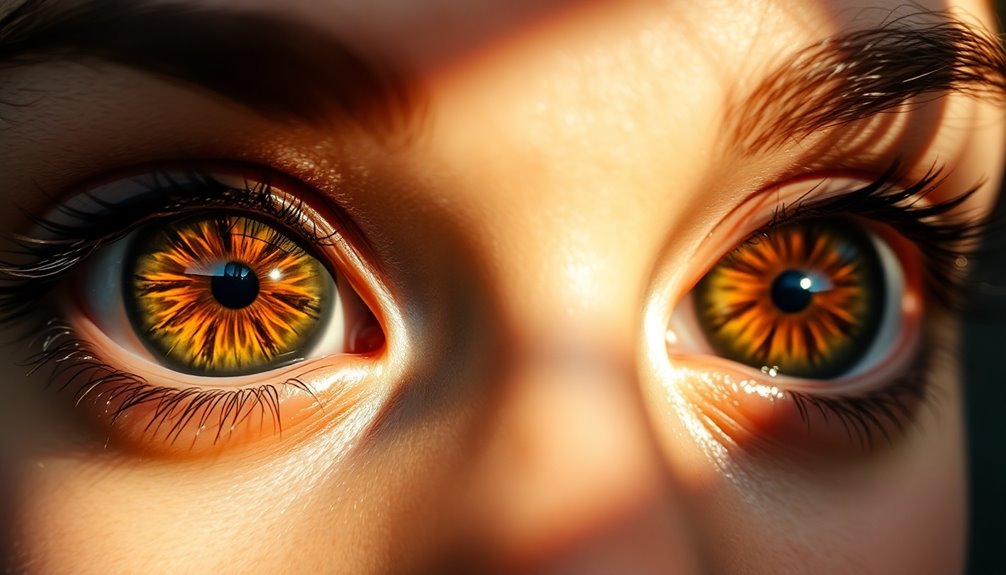
Individuals with hazel eyes often exhibit a unique blend of personality traits that reflect their vibrant and dynamic nature. You might find that passion and compassion are central to your emotional expression, allowing you to connect deeply with others.
Your spontaneity and creativity may lead you to embrace new adventures, while your open-mindedness makes you receptive to different perspectives. Interestingly, hazel eyes are approximately 5% of the global population, which adds to their rarity and allure. People with hazel eyes often demonstrate remarkable resilience in the face of challenges, drawing strength from their emotional depth. This emotional depth can sometimes mirror the emotional dysregulation seen in individuals with certain personality disorders, such as Borderline Personality Disorder.
You're likely known for your enthusiasm, intensity, and fierce devotion to your loved ones, traits that make you a supportive friend and partner. Your intelligence and wit often shine through, drawing people to you.
Because you're highly adaptable, you thrive in various situations, easily switching between different traits to fit the moment.
Your hazel eyes are particularly expressive, revealing your genuine emotions. When you experience strong feelings, the colors in your eyes can change, making your gaze even more captivating.
This expressiveness can add an alluring quality to your personality, making you appear both mysterious and wise.
Historical Beliefs and Folklore
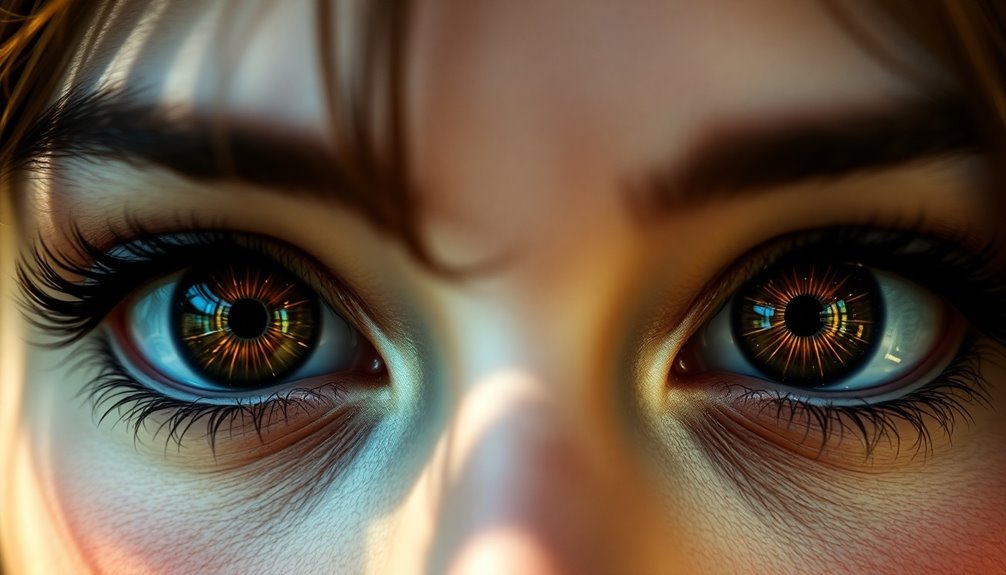
Throughout history, hazel eyes have been steeped in rich symbolism and cultural significance. In Celtic mythology, hazel trees are sacred, seen as a source of wisdom and insight. The nuts from these trees were believed to offer glimpses into the future, connecting hazel-eyed individuals to ancient knowledge and intuition. Additionally, individuals with hazel eyes are often encouraged to be aware of symptoms of breast cancer, as early detection can greatly improve health outcomes. Prophetic dreams, often seen as a source of divine communication, may also provide insights for those with hazel eyes.
You might find that those with hazel eyes are often regarded as wise, reflecting a strong bond with nature and the divine. In fact, approximately 5% of the global population possesses hazel eyes, making them a symbol of rarity and uniqueness. The connection to nature is also mirrored in the work of the Center for Aboriginal Health, which emphasizes the importance of traditional healing practices. This emphasis on healing resonates with the concept of emotional well-being, highlighting the role that physical health plays in overall life satisfaction.
In Native American culture, hazel eyes symbolize healing and renewal. People with this eye color are thought to possess special spiritual gifts, such as the ability to communicate with nature spirits and guide lost souls back to their communities. Their eyes signify a deep connection to both physical and emotional well-being.
In Eastern and Middle Eastern traditions, hazel eyes relate to adaptability and creativity, celebrated in poetry and art as symbols of beauty. The unique blend of colors is compared to precious stones, emphasizing rarity and allure.
In ancient Egyptian and Irish mythology, hazel eyes are tied to concepts of rebirth, knowledge, and spiritual enrichment. This rich tapestry of beliefs highlights the multifaceted nature of hazel eyes throughout history.
Scientific and Physical Aspects

Hazel eyes captivate with their unique blend of colors, and their genetic roots reveal a complex interplay of traits. At least 16 different genes influence your eye color, controlling the amount and distribution of melanin within the iris. Hazel is a dominant trait, meaning even a single copy of the gene can lead to this eye color. However, the exact genetics behind hazel eyes are intricate and not fully understood.
The pigment melanin is responsible for the color and is present in moderate amounts in hazel eyes—more than in green eyes but less than in brown. You might notice that melanin often concentrates in the outer part of the iris, leaving the inner section lighter. As a baby, you could start with blue eyes and later develop hazel as melanin accumulates. Interestingly, two blue-eyed parents can occasionally have a child with hazel or even brown eyes, showcasing the complexity of genetic inheritance. Investment in precious metals can serve as an effective hedge against inflation, similar to how the unique qualities of hazel eyes may provide an intriguing advantage in aesthetic appeal. Additionally, the presence of antioxidants in coffee supports overall eye health, highlighting the importance of nutrition. Sustainable coffee brands often focus on ethical sourcing, which can be beneficial for overall well-being. Furthermore, consuming beverages like yerba mate can also contribute to antioxidant intake, promoting eye health.
Physically, hazel eyes are a mix of brown and green, with variations depending on light exposure. The way light scatters through hazel irises, a phenomenon known as Rayleigh scattering, contributes to their dynamic appearance.
However, it's important to remember that hazel eyes are more susceptible to UV damage and light sensitivity, so protecting them from sunlight is essential. Regular eye exams are vital for maintaining their health.
Myths and Misconceptions

Many misconceptions surround hazel eyes, often fueled by cultural beliefs and popular myths. One common myth is that hazel eyes change color based on mood or lighting, but in reality, it's merely a trick of light and surrounding colors. The unique pigmentation of hazel eyes creates an illusion of shifting hues, while your eye color remains constant throughout your life. Additionally, the variability in appearance is influenced by lighting and surroundings, further enhancing the captivating nature of hazel eyes.
Another misconception is the rarity of hazel eyes. In truth, they're found in about 5% of the global population—less common than brown or blue, but certainly not unique. You can find hazel eyes across various ethnicities, debunking the idea that they belong to a specific group.
Additionally, many believe hazel eyes correlate with certain personality traits, like creativity or mystery. However, there's no scientific evidence to support these claims. Instead, these perceptions stem from cultural stereotypes rather than proven facts.
Finally, some people tie hazel eyes to supernatural qualities. While historical beliefs may associate them with magic, these notions lack scientific backing. Instead, hazel eyes' allure lies in their complex beauty, not any mystical attributes.
Symbolism in Art and Literature

Eyes often serve as windows to the soul, and hazel eyes, in particular, have captivated artists and writers alike for centuries. These eyes symbolize depth and mystery, often portrayed with a quiet intensity that leaves a lasting impression. In many cultures, spiritual principles associated with eye colors often reflect deeper meanings, adding to the allure of hazel. Additionally, the enchanting qualities of hazel eyes often draw comparisons to the introspection and growth found in personal transformation narratives. Understanding the complexities of human emotions, such as those experienced in narcissistic relationships, can further enhance the appreciation of this eye color's symbolism. The integration of advanced features in modern storytelling, such as those enabled by generative AI, allows for even more intricate character development that mirrors the complexity of hazel eyes.
In literature, characters with hazel eyes are memorable and intriguing, reflecting both strength and sensitivity. The shifting colors of hazel are reminiscent of nature's transformations, like autumn leaves or a sunrise. This dynamic quality aligns with the literary theme of knowledge and perception that hazel eyes can embody.
Emotionally, hazel eyes convey feelings that words might fail to express, revealing vulnerability or sorrow. They create a connection to the soul, showcasing the inner world of the character. In romantic narratives, the gaze of someone with hazel eyes can evoke passion and longing, enriching the emotional landscape.
Culturally, hazel eyes carry significance across various traditions. In folklore, they're seen as mystical, possessing the ability to see beyond the physical realm. Many cultures celebrate hazel eyes for their wisdom, intuition, and creativity. This unique eye color inspires poets and painters, capturing its allure and celebrating individuality and authenticity in art and literature.
Hazel eyes invite you to explore themes of perception, understanding, and revelation in the creative realm.
Famous People With Hazel Eyes

Throughout the entertainment industry, several famous personalities are known for their captivating hazel eyes. Take Rihanna, for instance, whose eyes blend stunning gold and green hues, drawing you in with every glance. Angel numbers often appear in repeating sequences, serving as a reminder of the spiritual energy that connects us all.
Then there's Lady Gaga, whose hazel eyes shimmer with similar vibrant colors. Flower teas can also enhance skin vitality, contributing to the overall allure of hazel-eyed celebrities. Zendaya's eyes are a versatile mix, ranging from golden to green-tinted, while Kristen Stewart showcases a striking green emphasis. The unique color accuracy of hazel eyes enhances their visual appeal, making them even more captivating. Additionally, herbal remedies that promote skin vitality can contribute to the overall allure of hazel-eyed celebrities.
In the realm of film, Tom Cruise's hazel eyes dominate with green tones, and Mila Kunis flaunts a mix of brown, green, and gold. Understanding the meanings of angel numbers can deepen one's appreciation for the beauty found in various features, including eye color.
Sofia Vergara's hazel eyes create an ombre effect, shifting from dark green on the outside to a golden inner. Jada Pinkett Smith stands out with piercing hazel eyes, perfectly complemented by her short hair.
Even in the world of sports, David Beckham's hazel eyes blend green, blue, brown, and gold, while Orlando Bloom is renowned for his stunning gaze. The unique genetic factors behind hazel eye color contribute to their captivating allure.
Olivia Wilde sometimes gets described with hazel tones due to her golden-hued eyes. From music to film and sports, these celebrities prove that hazel eyes aren't just beautiful; they're a captivating feature that many admire.
Personal Reflections on Hazel Eyes
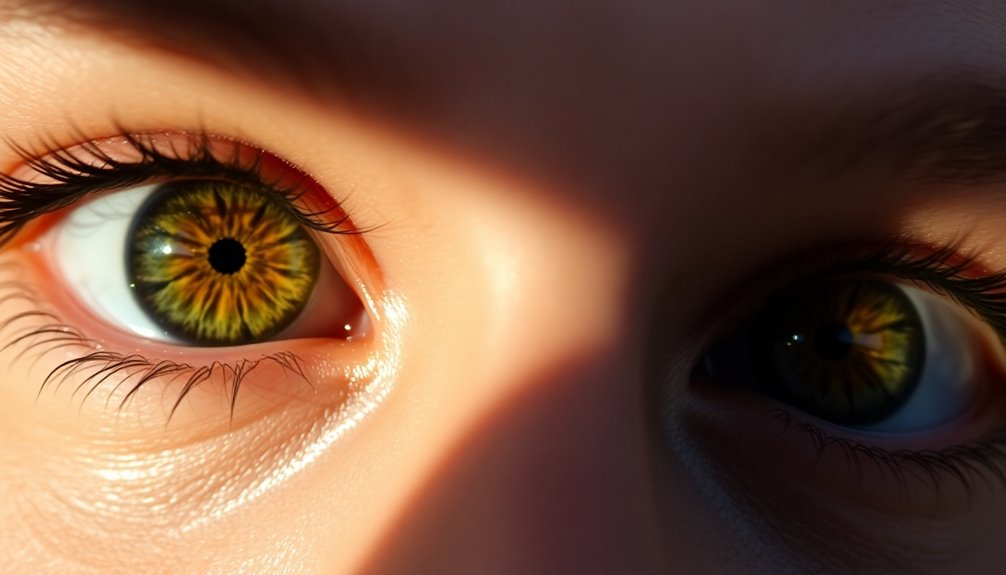
There's something undeniably intriguing about hazel eyes that captures your attention. Their unique blend of brown, green, and gold creates a mesmerizing depth that reflects the soul within.
You might find that people with hazel eyes often possess a dynamic personality, marked by spontaneity and a zest for adventure. This adaptability allows them to thrive in various situations, showcasing intelligence and wit. In fact, they are often seen as adventurous and open-minded individuals who embrace life's challenges, often demonstrating the importance of establishing healthy boundaries in their relationships. The ability to read emotions effectively can lead to deeper connections in their interactions, similar to the ways in which emotional alignment plays a vital role in maintaining successful relationships.
Emotionally, hazel eyes are incredibly expressive, revealing genuine feelings and conveying empathy. You may notice how they can read emotions and nuances in conversation, bringing a sense of calm and clarity to those around them. This quiet intensity often adds an air of mystery, making interactions with them even more captivating.
Historically, hazel eyes symbolize transformation and growth, embodying a deep connection to nature. Their beauty has inspired artists and poets, celebrated for their versatility that balances strength and vulnerability. As you gaze into hazel eyes, you're not just looking at a color; you're witnessing a rich tapestry of emotion, experience, and an adventurous spirit, making every glance a moment of connection and intrigue.
Frequently Asked Questions
Are Hazel Eyes Considered More Attractive Than Other Eye Colors?
Yes, hazel eyes are often considered more attractive than other eye colors.
In online dating, they boast a notable match rate, reflecting a widespread appeal. Their unique blend of colors makes them stand out, and many find their mysterious quality captivating.
While preferences can vary, surveys consistently show that light-colored eyes, including hazel, are generally perceived as the most beautiful.
Do Hazel Eyes Have Any Health Implications?
Yes, hazel eyes do have health implications.
You're at a higher risk for conditions like uveal melanoma and age-related macular degeneration due to less pigment in your iris. This lack of pigment also increases the chances of corneal opacity, cataracts, and refractive errors.
Additionally, hazel eyes are linked to a greater risk of skin cancers, so regular eye exams and sun protection are essential for monitoring and maintaining your eye health.
Can Hazel Eyes Change With Age?
Yes, hazel eyes can change slightly with age.
As you age, the density of melanin in your eyes may increase or decrease, causing minor shifts in color. You might notice your hazel eyes showing more pronounced green or brown tones over time.
However, these changes are subtle and don't typically result in a complete color shift. So while your hazel eyes may evolve, their fundamental hue usually remains stable throughout your life.
What Celebrities Have the Most Notable Hazel Eyes?
When you think about celebrities with notable hazel eyes, several icons come to mind.
Rihanna's striking hazel eyes feature flecks of green and brown, while Lady Gaga showcases blends of gold and green.
You can't overlook Zendaya, whose golden-hued eyes captivate many.
Tom Cruise and Mila Kunis also stand out, each offering their unique take on hazel.
These stars demonstrate the beauty and diversity of hazel eyes in the entertainment world.
How Can I Enhance the Appearance of My Hazel Eyes?
To enhance your hazel eyes, play with eyeshadow colors like copper, gold, or emerald to highlight their unique flecks.
You can use purple eyeliner for a striking contrast, and mascara focused on your outer lashes will make your eyes pop.
Don't forget to apply a shimmery highlighter in the inner corners to brighten your gaze.
Finally, consider framing your face with layers that draw attention to your beautiful eyes.
Conclusion
In exploring the symbolism of hazel eyes, you uncover a rich tapestry of meanings that span cultures and history. Their unique blend of colors reflects a deep connection to nature and insight into personality traits. Whether in art, folklore, or the lives of famous individuals, hazel eyes carry an allure that captivates and inspires. Embrace the multifaceted beauty of hazel eyes, and let their gaze remind you of the depth and complexity within us all.

